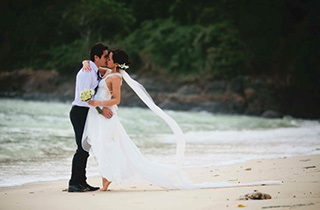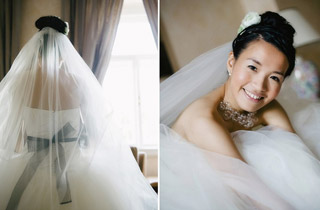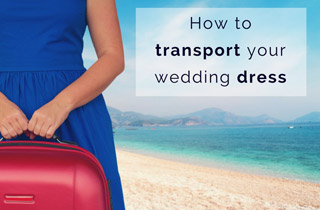How to choose the right fabrics and dress styles for hot, cold or changeable weather.
When getting married abroad, you will need to consider the climate of your chosen location as well as the setting. Getting it wrong can really spoil your wedding day, after all you don’t want sweaty underarm stains. So, when choosing wedding dresses for weddings abroad it’s important to follow the basic guidelines below.
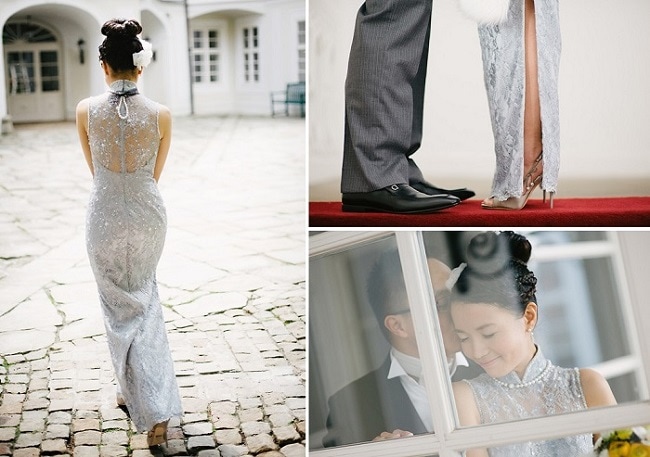
Vicky’s elegant Qiapo Chinese dress
Don’t be worried if your dream dress doesn’t seem the most practical, most dresses can be adapted to most climates. If you can, tell you dress maker as soon as possible in the process, they will be able to advise you of any adaptations you may need to make.
Happy shopping!
Wedding dresses for weddings abroad in hotter climates
As with all gowns, you should wear them and they should not wear you. This is especially the case with a gown in a hot climate. It’s important to consider the design, the fabric and when and where you will be wearing your wedding dress. Be aware that one beach location is not the same as another, will it be humid or is the climate drier and breezier.
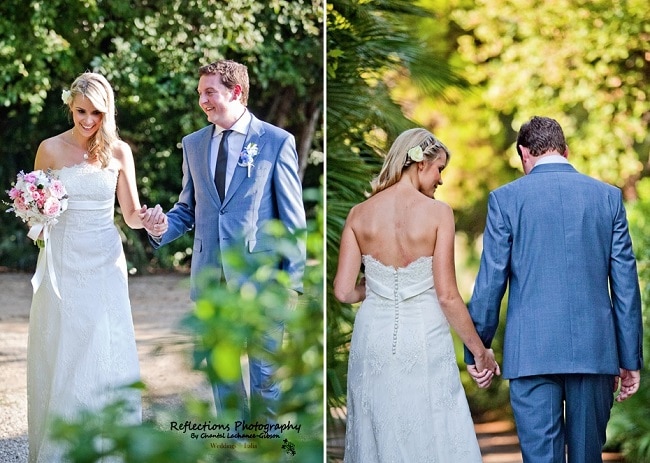
Caro’s Summer wedding dress
Tips for Warmer Climates:
The fabric and design of wedding dresses for weddings abroad in hotter climates are of course linked to the climate, the location and your own style.
1) Natural Fabrics
If you still want a formal or traditional dress, you should consider a lightweight fabric, ideally a natural fabric such as silk, as these will ‘breathe’ in the heat (and you won’t sweat so much!).
2) The Creasing Factor
There are drawbacks to natural fabrics though; hot and humid environments mean that natural fabrics will crease easily, think about whether you’ll need to sit down for long periods before your photos (e.g. in a car on the way there). You can get mixes of fabrics which will make them harder to crease but these may not suit your gown.
3) Practicalities
The style of your gown can dictate what kind of fabric might be suitable – practicalities are less glamorous than your big day but need consideration if you want to stay looking good.
4) Dress Shields
For example, if you would like a traditional gown with sleeves, be aware that you’ll sweat, look into dress shields which fit under your arms and will stop any possible staining of your dress.
5) Getting Ready
Try to make sure you dress in a cool place, especially if you have a tight fitting bodice, it will be much harder to position and fasten if you are already hot. If you are wearing a strapless or backless dress remember to remove your underwear well in advance to avoid pressure marks from the straps, equally make sure that you apply sun block before your dress, try a clear and less greasy formula – make sure it is dry before you dress.
6) Fake Tan / Sun Block
If you have to apply fake tan, apply it the day before or if it’s tanning make up let it dry completely. Most wedding fabrics will not sponge clean, trying to remove sun block, makeup or moisturiser will make the stain worse!
Shoes
You need to think about your shoes and the surfaces you will be walking on. While beaded barefoot beach wedding sandals look gorgeous, you may find that the sand is just too HOT! If you would like a little height, consider a fashionable and functional wedge heal.
Wedding Dresses for weddings abroad in colder climates
Planning to ski into your own wedding? I’m sure that you can get some great white salopettes but in case your wedding dress has to adapt to the cold there are few things to remember…

Lesley-Anne’s Winter wedding dress
Tips for Cooler Climates:
The fabric and design of wedding dresses for weddings abroad in colder climates are of course linked to the climate, the location and your own style.
7) Removable
You’re only likely to spend a small amount of time in the cold so it’s best that the insulating part of your gown is warm and can be removed.
8) Natural Fabrics
As natural fabrics breathe in hot weather, they can also be the warmest when layered together. Silk, silk velvet, double layer fine wool will all offer a warm cover over a more temperate weather dress.
9) Prepare for Rain
If there’s a chance that it may rain, apart from the best man not forgetting the umbrella it’s important to remember that fabrics such as duchess satin will stain on contact with water. Go prepared, just in case…
Shoes
If getting married in the snow, then you may want more than one pair of shoes. Stylish snow boots will keep you warm and cosy outside while a more traditional wedding shoe can be worn at the reception. For a little inspiration take a look at our “destination wedding shoes” board on pinterest.
Further Reading:
For Expert Tips on how to dress for comfort and stay warm without sacrificing your style read our Winter Wedding specialists advice – What to wear for a Winter Wedding.
Real Experiences!
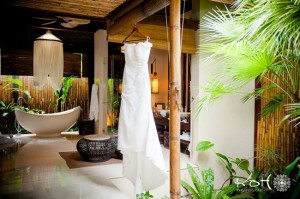
For further inspiration to help you choose your perfect wedding dress, have a look at the photographs of the dresses that the real brides featured on Weddings Abroad Guide wore on their wedding day.

